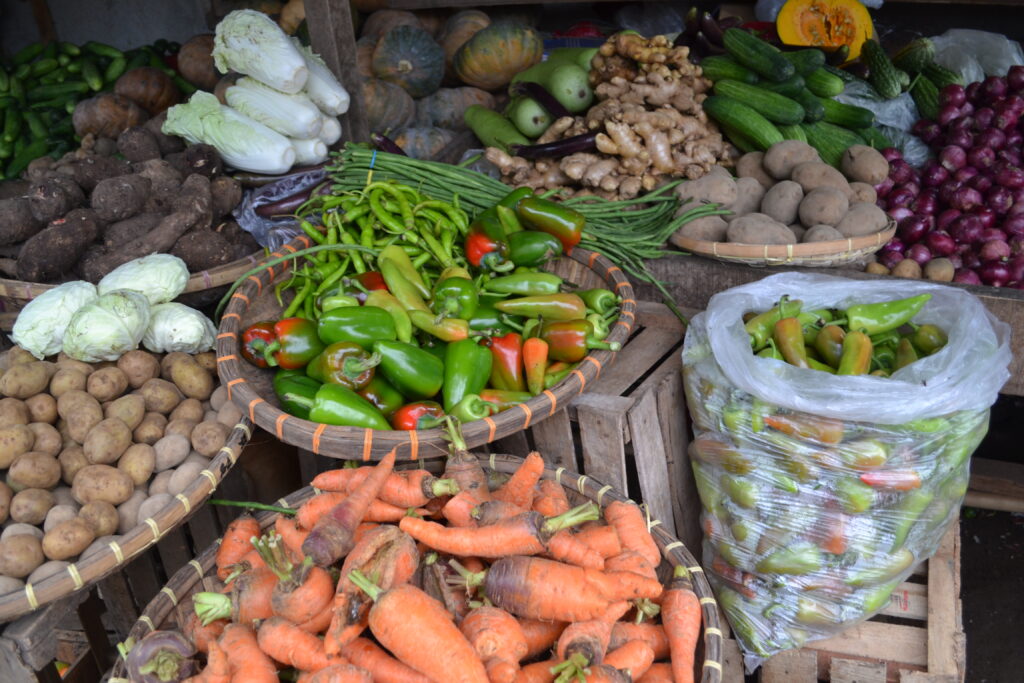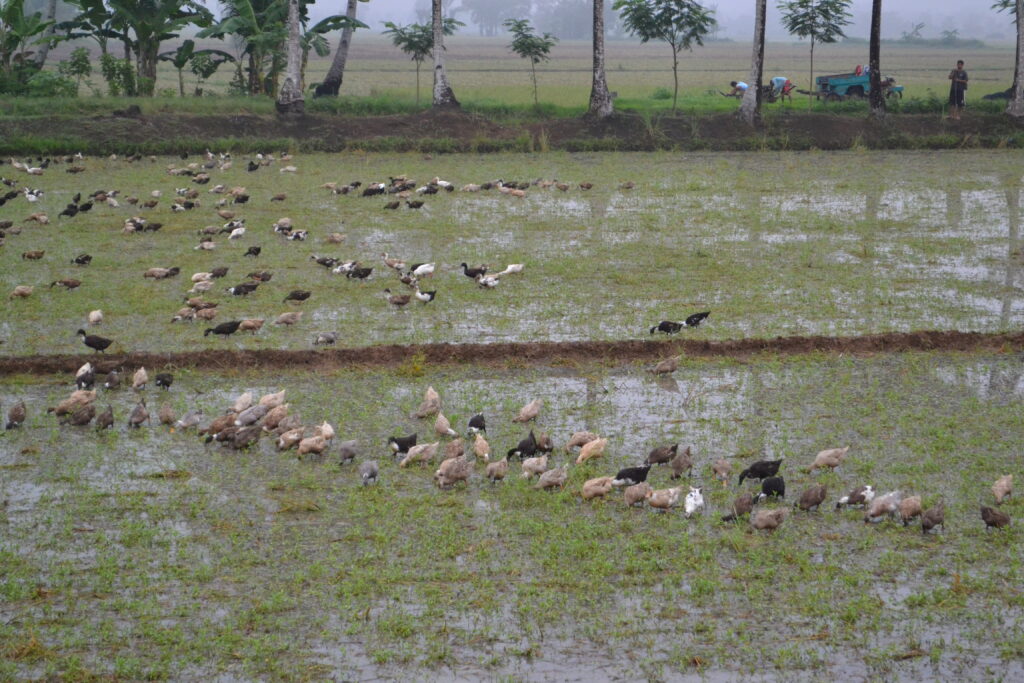Text and Photos by Henrylito D. Tacio
Is there a possibility that a part of the problem can also be a part of the solution?
Such is the case of agriculture in times of climate change.
A case in point is a hamburger, that flat round cake of ground beef served fried or broiled often in a bun. It has been found that hamburger fosters the destruction of the ecologically-fragile tropical forests.
“A hamburger is apparently equal to the destruction of rainforests and conversion of rainfall and transformation of grains and crops into waste,” said Haribon, one of the country’s most outspoken environmental groups, in a statement.
Hamburgers come from cattle, which are raised in areas that used to teem with forests. The World Rainforest Movement website shared this information: “During the eighties, two factors led to increased exports of beef from the tropical region of Latin America with the consequent aftermath of accelerated deforestation of the Amazon. On the one hand, increased consumption of beef in the countries of the North (particularly for fast food chains in the United States) and on the other, lower prices of land and labor in the tropical countries of Latin America, making the final product cheaper.”

The denudation of the Amazon forest
The Bogor-based Center for International Forestry Research, in a report, has identified the expansion of cattle raising as “one of the factors responsible for the recent increase in the destruction of the Brazilian Amazon forest.”
Once the trees are cut and burned, carbon dioxide – one of the culprits of climate change – is released into the atmosphere. “By most accounts, deforestation in tropical rainforests adds more carbon dioxide to the atmosphere than the sum of cars and trucks on the world’s roads, according to “Scientific American.”
The US publication quoted World Carfree Network, which said that cars and trucks account for about 14% of global carbon emissions, while most analysts attribute upwards of 15% to deforestation.
“The reason that logging is so bad for the climate is that when trees are felled they release the carbon they are storing into the atmosphere, where it mingles with greenhouse gases from other sources and contributes to global warming accordingly,” the publication pointed out.
Greenhouse gases
Aside from carbon dioxide, other greenhouse gases include chlorofluorocarbons (from air conditioners and refrigerators), methane gas (from landfills and feedlots), and nitrogen compounds. Ground-level ozone, produced by burning fossil fuels, is also considered a greenhouse gas.
Among the most apparent consequences of climate change are sea-level rise, less rainfall, drought, and floods. All these affect food production. “Despite the technological advances in the second half of the 20th century, agriculture remains to be one of the most vulnerable sectors to climate change,” notes Apple Jean C. Martin in policy advocacy.
“Agriculture is extremely vulnerable to climate change,” the Washington-based International Food Policy Research Institute (IFPRI) policy report agrees. “Higher temperatures eventually reduce yields of desirable crops while encouraging weed and pest proliferation. Changes in precipitation patterns increase the likelihood of short-run crop failures and long-run production declines.”

According to the IFPRI report, populations in the developing world, which are already vulnerable and food insecure, are “likely to be the most seriously affected.” In 2005, nearly half of the economically active population in developing countries – 2.5 billion people – relied on agriculture for its livelihood. Today, 75% of the world’s poor live in rural areas!
Filipinos facing hunger
Currently, the Philippines is home to more than 100 million Filipinos. “With decreasing land area devoted to agriculture, higher prices of agricultural inputs, lesser people engaging into agriculture and education in agriculture, and now, the advent of climate change, feeding the nation is a huge challenge,” writes Amavel A. Velasco in an article which appeared in BAR Digest, a publication of the Bureau of Agricultural Research.
According to the Department of Agriculture, the country’s population is predominantly rural (70%), and two-thirds of the population depends on farming for their livelihood. In terms of employment, about one-half of the labor force is engaged in agricultural activities.
Unfortunately, their work and other activities are being threatened with climate change. “Between 1971 and 2000, mean annual, maximum, and minimum temperatures in the country have increased by 0.14 degrees Centigrade,” said a report released by the Laguna-based Philippine Council for Agriculture, Aquatic, Forestry and Natural Resources Research and Development (PCARRD).
Rice and methane
Since agriculture is part of the problem, can it help minimize the impact of the problem? Take the case of rice, the staple food of most Filipinos. Rice fields have been cited as one of the major contributors of methane in the atmosphere. The journal “Science” reported that the atmospheric concentration of methane has more than doubled during the last 300 years and is increasing at an annual rate of about one percent each year.
“Rice is a plant that grows best in wet soil, with its roots flooded,” says L. Hartwell Allen, an American soil scientist at the Crops Genetics and Environmental Research Unit in Gainesville, Florida. “But flooded rice crops emit substantial amounts of methane to the atmosphere.”
Scientists explain that long-term flooding of the fields cuts the soil off from atmospheric oxygen and causes anaerobic fermentation of organic matter in the soil. During the wet season, rice cannot hold the carbon in anaerobic conditions. The microbes in the soil convert the carbon into methane, which is then released through the respiration of the rice plant or through the diffusion of water.
On the other hand, the decomposition of organic material in flooded rice fields produces methane, which then escapes to the atmosphere during the growing season. “Traditionally, farmers flood their rice fields continuously and incorporate 4-5 tons of rice straw per hectare at land preparation,” says a PCAARRD report. “Every year, these practices release 5,883 tons of methane to the atmosphere.”
Science-based strategies
In Isabela State University, a study funded by PCAARRD showed that by using simple science-based strategies, farmers could contribute significantly to the reduction of methane emissions. For instance, mid-season drainage of irrigation water reduced methane emission by 48 percent.
Meanwhile, composting of rice straw resulted in 64% less methane emission released in the air. By combining mid-season drainage and application of rice straw compost, methane emission is further reduced by 81%.
“By shifting to climate-change friendly farming practices, as what was done in the 7,789.34 hectares of lowland irrigated rice in Isabela, farmers can get incremental benefits amounting to as P138.95 million per year,” the PCARRD report points out.
Duck-rice integration
Another way of checking the release of methane into the atmosphere is by raising ducks in rice fields. Some farmers in Zamboanga del Sur are doing this. Nonoy E. Lacson, in a report, wrote: “Under the system, ducklings are released to rice fields to graze and feed. The paddling movement of the ducks in the rice fields increases the rice tillers, in effect raising annual yield by as much as 10-15%. Besides their paddling, ducks also eat the insects and unwanted weeds in the rice field.”
Some studies conducted in China showed that the constant paddling of ducks in rice fields helps contain the methane and nitrous oxide to be released into the atmosphere.

In addition, the integrated rice-duck farming system is one of the best strategies in increasing rice productivity, according to the Department of Agriculture. For one, it reduces labor for farmers, and second, it lessens the use of commercial fertilizers and chemicals.
“The integrated rice-duck technology reduces the use of chemicals,” the agriculture department pointed out. “Since ducks are grown alongside rice paddies, they eat harmful pests at the same time their dung fertilizes the soil. Their paddling movement cultivates the soil and destroys the weeds. Its benefits to the farmers are immediately felt and tangible.”
Planting pulses
Pulses – those annual crops that yield between one and 12 grains per seeds – are not popular among Filipinos. But eating and planting them could help lessen the production of greenhouse gases released into the atmosphere.
Pulses utilize soil bacteria to draw nitrogen from the air. This natural process replaces the need to add nitrogen fertilizers in pulse crops, which means pulses use half the energy inputs of other crops.
“When soil is fertilized with nitrogen in the form of manure, fertilizer, or crop residue,” the UN Food and Agriculture Organization (FAO) explained, “soil microorganisms convert some of this nitrogen into nitrous oxide, which is a powerful greenhouse gas.”
According to the United Nations Environment Program, nitrous oxide is 300 times more potent than carbon dioxide and represents around 46% of greenhouse gas emissions from global agriculture.
“Since greenhouse gas emissions related to crop production are largely driven by nitrogen fertilizers, nitrogen-fixing pulse crops have a lower carbon footprint compared to other crops,” FAO said.

